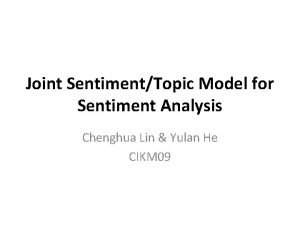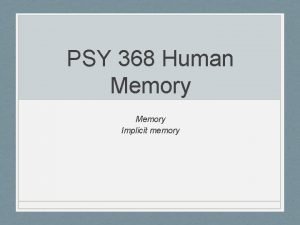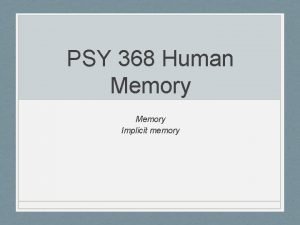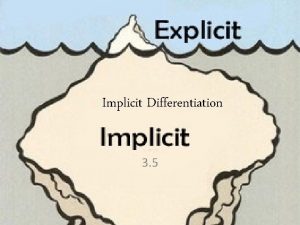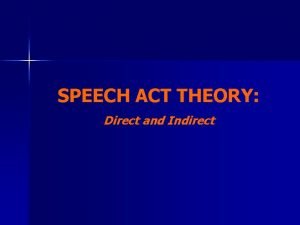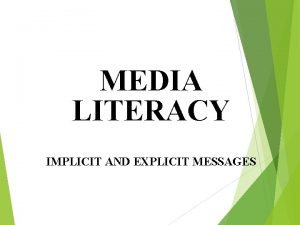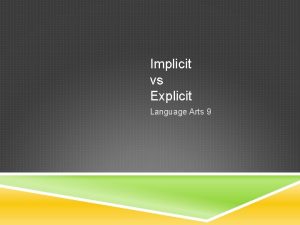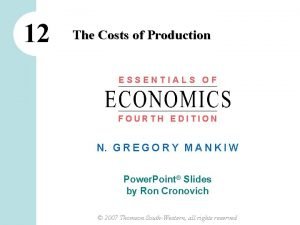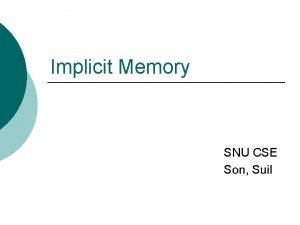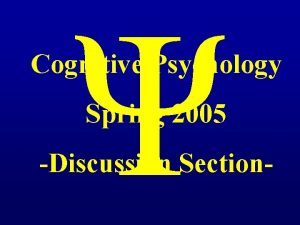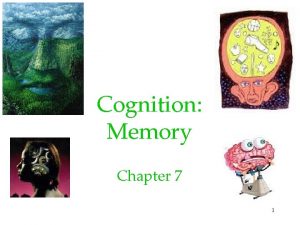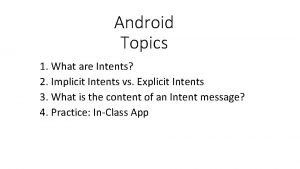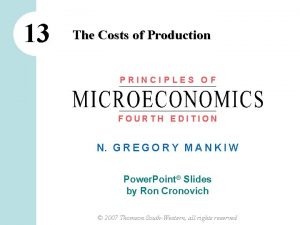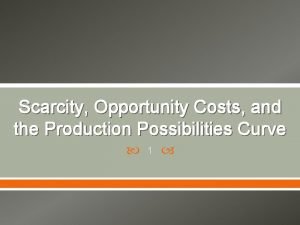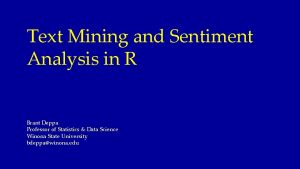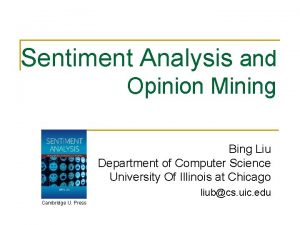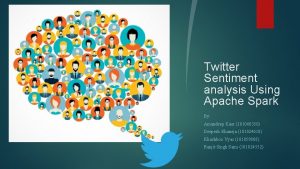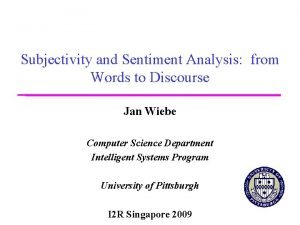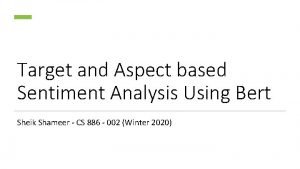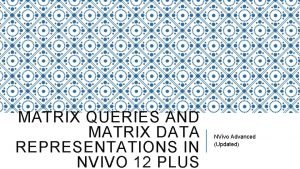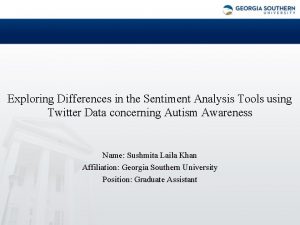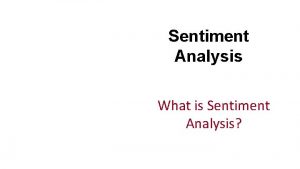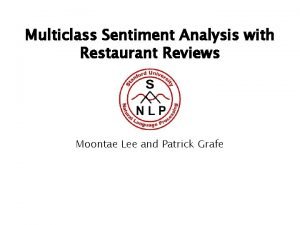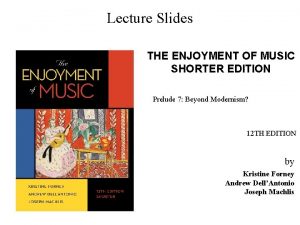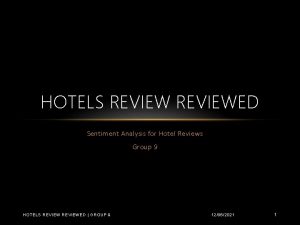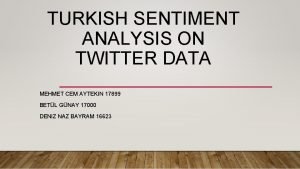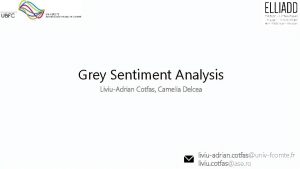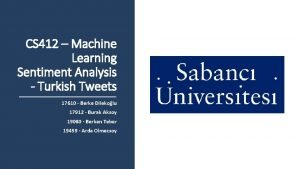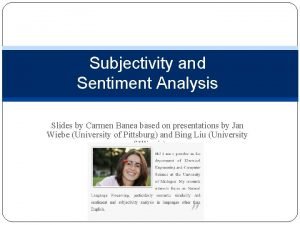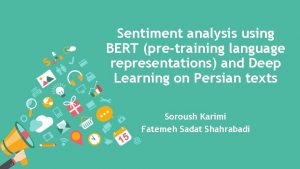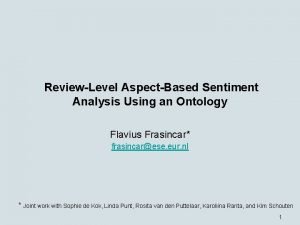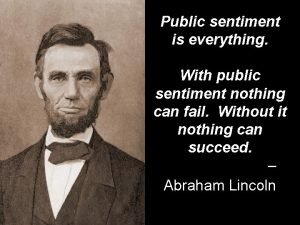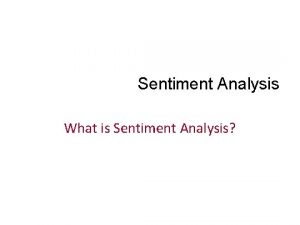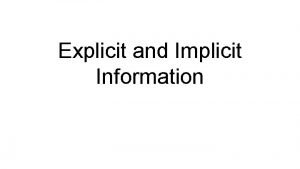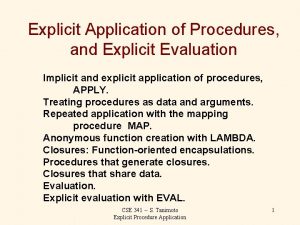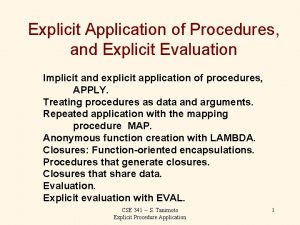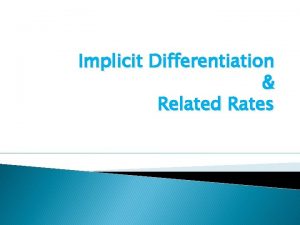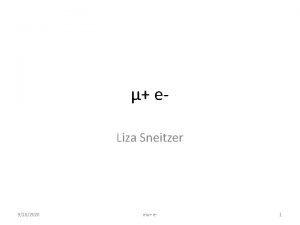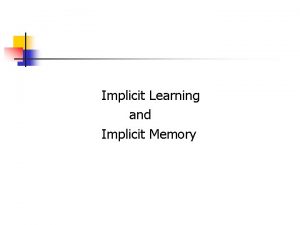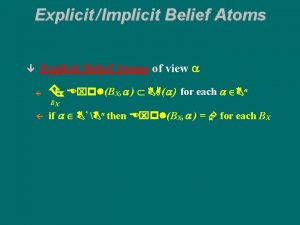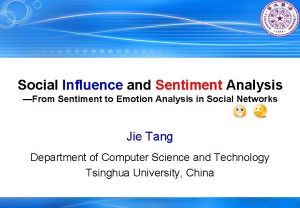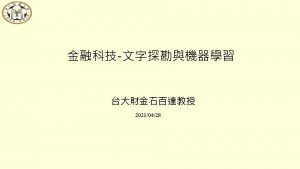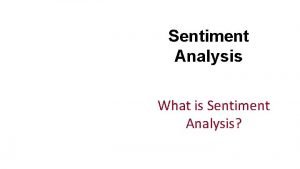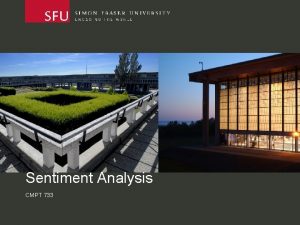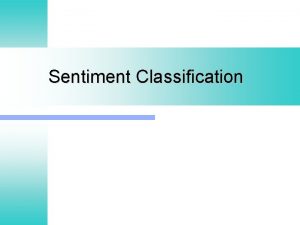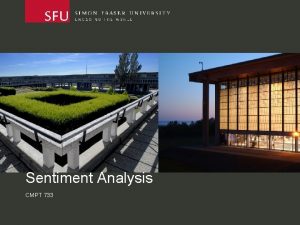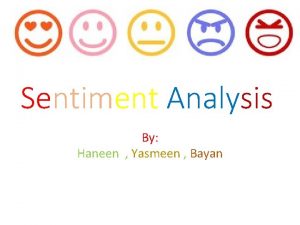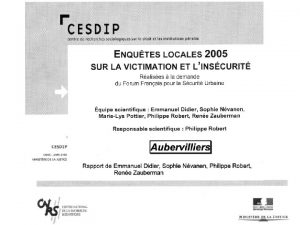9182020 A Framework for Explicit and Implicit Sentiment






































![Sentiment Propagation Sentiment Frame Extraction 9/18/2020 [Deng and Wiebe EACL 2014] Won’t talk more Sentiment Propagation Sentiment Frame Extraction 9/18/2020 [Deng and Wiebe EACL 2014] Won’t talk more](https://slidetodoc.com/presentation_image/5c86c3a5457661b5bd5b5cc6d43f4880/image-39.jpg)
![[Deng, Choi, Wiebe COLING 2014] Outline item 3 Sentiment Frame Extraction 9/18/2020 Joint Inference [Deng, Choi, Wiebe COLING 2014] Outline item 3 Sentiment Frame Extraction 9/18/2020 Joint Inference](https://slidetodoc.com/presentation_image/5c86c3a5457661b5bd5b5cc6d43f4880/image-40.jpg)


![Explicit Opinion-Frame Extraction 9/18/2020 Rule-Based System [Wiebe and Deng ar. Xiv 2014] Assumes prior Explicit Opinion-Frame Extraction 9/18/2020 Rule-Based System [Wiebe and Deng ar. Xiv 2014] Assumes prior](https://slidetodoc.com/presentation_image/5c86c3a5457661b5bd5b5cc6d43f4880/image-43.jpg)
![Explicit Opinion-Frame Extraction 9/18/2020 Rule-Based System [Wiebe and Deng ar. Xiv 2014] Fuller rule Explicit Opinion-Frame Extraction 9/18/2020 Rule-Based System [Wiebe and Deng ar. Xiv 2014] Fuller rule](https://slidetodoc.com/presentation_image/5c86c3a5457661b5bd5b5cc6d43f4880/image-44.jpg)





















![[Deng, Choi, Wiebe COLING 2014] Sentiment Frame Extraction 9/18/2020 Joint Inference using ILP Recognizing [Deng, Choi, Wiebe COLING 2014] Sentiment Frame Extraction 9/18/2020 Joint Inference using ILP Recognizing](https://slidetodoc.com/presentation_image/5c86c3a5457661b5bd5b5cc6d43f4880/image-66.jpg)









![Data • MPQA plus new annotations added recently [Deng and Wiebe NAACL 2015] supports Data • MPQA plus new annotations added recently [Deng and Wiebe NAACL 2015] supports](https://slidetodoc.com/presentation_image/5c86c3a5457661b5bd5b5cc6d43f4880/image-76.jpg)







![Explicit Opinion-Frame Extraction 9/18/2020 Rule-Based System [Wiebe and Deng ar. Xiv 2014] Recognizing +/-Effect Explicit Opinion-Frame Extraction 9/18/2020 Rule-Based System [Wiebe and Deng ar. Xiv 2014] Recognizing +/-Effect](https://slidetodoc.com/presentation_image/5c86c3a5457661b5bd5b5cc6d43f4880/image-84.jpg)

























- Slides: 109

9/18/2020 A Framework for Explicit and Implicit Sentiment Analysis in Text and Dialog Janyce Wiebe Department of Computer Science Intelligent Systems Program University of Pittsburgh 1

• A great deal of recent work [Liu 2012; 2015; Pang and Lee 2008] • Many different terms • Ours [Wiebe CL 1994&2004; Wiebe et al. LRE 2005; Deng & Wiebe NAACL 2015] • Opinion (general term) • Private State: <source, attitude, target> • Sentiment: positive and negative evaluations and emotions • Subjective expression: linguistic expression of a private state • Many advances have been made in NLP • Assess the overall sentiment of a document • Assess whether a sentence is opinionated • Fine-grained extraction of opinion frames. . . 9/18/2020 Sentiment and Opinion Analysis 2

Opinion Frame Extraction IS-ABOUT IS-FROM Target Source Subjective Chavez faced America 's hostility Opinion/subjective expression Opinion attribute Opinion argument Opinion Frame Trigger: “hostility” Polarity: negative Intensity: high Source: “America” Target: “Chavez”

Opinion Frame Extraction IS-ABOUT IS-FROM Target Source Subjective Chavez faced America 's hostility Most fine-grained work is on expression extraction Opinion/subjective expression Opinion attribute Opinion argument Opinion Frame Trigger: “hostility” Polarity: negative Intensity: high Source: “America” Target: “Chavez”

Opinion Frame Extraction IS-ABOUT IS-FROM Target Source Subjective Chavez faced America 's hostility Notable: work by Cardie and her group on joint extraction: • Expressions and sources [EMNLP 2006] • Expressions, sources, and targets [ACL 2013] • Expressions and attributes [TACL 2014/ACL 2015] Opinion Frame Trigger: “hostility” Polarity: negative Intensity: high Source: “America” Target: “Chavez”

• Previous NLP research has mainly addressed explicit opinion expressions • I support the bill + sentiment toward the bill • The car is wonderful + sentiment toward the car • That idiot -sentiment toward the referent 9/18/2020 Explicit Opinions • Oh no! The voters defeated the bill –sentiment toward the event • Yeah! The voters defeated the bill +sentiment toward the event 6

• • • However, many opinions are expressed implicitly via inference Oh no! The voters defeated the bill –sentiment toward the event Oh no! The voters defeated the bill Yeah! The voters defeated the bill +sentiment toward the event Yeah! The voters defeated the bill Explicit recognition is not enough • Different targets (the voters; the bill) • Often, opposite polarities 9/18/2020 Explicit vs. Implicit Opinions 7

• Previous work focuses on assigning one single sentiment to a document, sentence, expression, phrase, word, sense • By inferring implicit opinions, system recognizes sentiments toward events and entities that are not direct targets of opinions, producing a richer interpretation 9/18/2020 Explicit AND Implicit Opinions • The bill would lower health care costs, which would be a tremendous positive change across the entire health-care system 8

• Conversational Implicatures (Grice 1975) -- defeasible inferences that may not go through in context • Sp 2: I have 3 children • Conversational implicature (inference): Sp 2 has exactly 3 children • But consider this context! • Sp 1: We need 3 children to hand out flyers at the faire. • Sp 2: I have 3 children … in fact I have 4! – thus defeating the inference in context 9/18/2020 Inferences addressed in this work 9

• Conversational Implicature -- defeasible inferences that may not go through in context • Arising from inference over directly expressed private states [Wiebe CL 1994&2004; Wiebe et al. LRE 2005; Deng & Wiebe NAACL 2015] • States of a SOURCE holding an ATTITUDE, optionally toward a TARGET • ATTITUDE TYPES: • Sentiment: positive and negative evaluations, emotions, and judgments – the main focus of this work • Belief and intention – play roles in the full set of rules in the rulebased system 9/18/2020 Inferences addressed in this work 10

• Conversational Implicatures -- defeasible inferences that may not go through in context • Arising from inference over directly expressed private states 9/18/2020 Inferences addressed in this work • AND Events that positively or negatively affect entities +/- effect events • Footnote: good. For/bad. For first few papers • Oh no! The voters defeated [-effect] the bill. • The bill would lower [-effect] health care costs, which would be a tremendous positive change across the entire health-care system • The bill will curb [-effect] skyrocketing health care costs. 11

The bill would lower health care costs, which would be a tremendous positive change across the entire health-care system.

The bill would lower health care costs, which would be a tremendous positive change across the entire health-care system.

The bill would lower health care costs, which would be a tremendous positive change across the entire health-care system.

<agent, -Effect, theme> The bill would lower health care costs, which would be a tremendous positive change across the entire health-care system.

The bill would lower health care costs, which would be a tremendous positive change across the entire healthcare system. Tremendous positive change W lower bill health care costs

The bill would lower health care costs, which would be a tremendous positive change across the entire healthcare system. +sentiment W -effect bill health care costs

The bill would lower health care costs, which would be a tremendous positive change across the entire healthcare system. ? +sentiment W -effect bill health care costs

The bill would lower health care costs, which would be a tremendous positive change across the entire healthcare system. -sentiment +sentiment W -effect bill health care costs

The bill would lower health care costs, which would be a tremendous positive change across the entire healthcare system. -sentiment +sentiment W ? -effect bill health care costs

The bill would lower health care costs, which would be a tremendous positive change across the entire healthcare system. -sentiment +sentiment W +sentiment -effect bill health care costs

The bill would lower health care costs, which would be a tremendous positive change across the entire healthcare system. -sentiment +sentiment W +sentiment -Effect bill health care costs

The bill would curb skyrocketing health care costs.

The bill would curb skyrocketing health care costs.

The bill would curb skyrocketing health care costs.

<agent, -Effect, theme> The bill would curb skyrocketing health care costs.

The bill would curb skyrocketing health care costs. skyrocketing W curb bill health care costs

The bill would curb skyrocketing health care costs. -sentiment W -Effect bill health care costs

The bill would curb skyrocketing health care costs. -sentiment ? W -Effect bill health care costs

The bill would curb skyrocketing health care costs. -sentiment +sentiment W -Effect bill health care costs

The bill would curb skyrocketing health care costs. -sentiment +sentiment W ? -Effect bill health care costs

The bill would curb skyrocketing health care costs. -sentiment +sentiment W +sentiment -Effect bill health care costs

The bill would curb skyrocketing health care costs. -sentiment +sentiment W +sentiment -Effect bill health care costs

9/18/2020 Explicit Opinion-Frame Extraction Recognizing +/-Effect Events and their polarities Inference Recognizing Connotations and their polarities Extracting Agents & Themes of +/-Effect Events 34

Opinion Polarity Source Extractor Target Extractor Semantic Role Labeling Word Sense Disambiguation +/- Effect Lexical Resources 9/18/2020 Opinion Extractor Co-reference Resolution Inference Entity Linking Semantic Composition Word Sense Disambiguation Connotation Lexical Resources Semantic Composition 35

Opinion Extractor Opinion Polarity Source Extractor Target Extractor Outline item 1 Semantic Role Labeling Word Sense Disambiguation +/- Effect Lexical Resources 9/18/2020 [Choi and Wiebe: EMNLP 2014 WASSA 2014] Co-reference Resolution Inference Entity Linking Semantic Composition Word Sense Disambiguation Connotation Lexical Resources Semantic Composition 36

Opinion Extractor Opinion Polarity Source Extractor Target Extractor Outline item 2 Semantic Role Labeling Word Sense Disambiguation +/- Effect Lexical Resources 9/18/2020 Coarse-grained WSD [Choi and Wiebe] Co-reference Resolution Inference Entity Linking Semantic Composition Word Sense Disambiguation Connotation Lexical Resources Semantic Composition 37

Opinion Polarity Source Extractor Target Extractor Semantic Role Labeling Word Sense Disambiguation +/- Effect Lexical Resources 9/18/2020 Opinion Extractor Co-reference Resolution Inference Entity Linking Semantic Composition Word Sense Disambiguation Connotation Lexical Resources Semantic Composition 38
![Sentiment Propagation Sentiment Frame Extraction 9182020 Deng and Wiebe EACL 2014 Wont talk more Sentiment Propagation Sentiment Frame Extraction 9/18/2020 [Deng and Wiebe EACL 2014] Won’t talk more](https://slidetodoc.com/presentation_image/5c86c3a5457661b5bd5b5cc6d43f4880/image-39.jpg)
Sentiment Propagation Sentiment Frame Extraction 9/18/2020 [Deng and Wiebe EACL 2014] Won’t talk more about this Recognizing +/-Effect Events and their polarities Inference Extracting Agents & Themes of +/-Effect Events 39
![Deng Choi Wiebe COLING 2014 Outline item 3 Sentiment Frame Extraction 9182020 Joint Inference [Deng, Choi, Wiebe COLING 2014] Outline item 3 Sentiment Frame Extraction 9/18/2020 Joint Inference](https://slidetodoc.com/presentation_image/5c86c3a5457661b5bd5b5cc6d43f4880/image-40.jpg)
[Deng, Choi, Wiebe COLING 2014] Outline item 3 Sentiment Frame Extraction 9/18/2020 Joint Inference using ILP Recognizing +/-Effect Events Inference Recognizing +/-Effect polarities Extracting Agents & Themes of +/-Effect Events 40

Sentiment Frame Extraction Recognizing +/-Effect Events Inference Recognizing +/-Effect polarities Richer sources, targets, and rules; fully automatic 9/18/2020 Joint Prediction for Entity/ Event Sentiment Analysis Using Probabilistic Soft Logic [Deng and Wiebe] Extracting Agents & Themes of +/-Effect Events 41

Outline item 4 Sentiment Frame Extraction 9/18/2020 Joint Prediction for Entity/ Event Sentiment Analysis Using Probabilistic Soft Logic [Deng and Wiebe] Recognizing +/-Effect Events Inference Recognizing +/-Effect polarities Extracting Agents & Themes of +/-Effect Events 42
![Explicit OpinionFrame Extraction 9182020 RuleBased System Wiebe and Deng ar Xiv 2014 Assumes prior Explicit Opinion-Frame Extraction 9/18/2020 Rule-Based System [Wiebe and Deng ar. Xiv 2014] Assumes prior](https://slidetodoc.com/presentation_image/5c86c3a5457661b5bd5b5cc6d43f4880/image-43.jpg)
Explicit Opinion-Frame Extraction 9/18/2020 Rule-Based System [Wiebe and Deng ar. Xiv 2014] Assumes prior NLP components exist and focuses on inferences themselves Recognizing +/-Effect Events and their polarities Inference Recognizing Connotations and their polarities Extracting Agents & Themes of +/-Effect Events 43
![Explicit OpinionFrame Extraction 9182020 RuleBased System Wiebe and Deng ar Xiv 2014 Fuller rule Explicit Opinion-Frame Extraction 9/18/2020 Rule-Based System [Wiebe and Deng ar. Xiv 2014] Fuller rule](https://slidetodoc.com/presentation_image/5c86c3a5457661b5bd5b5cc6d43f4880/image-44.jpg)
Explicit Opinion-Frame Extraction 9/18/2020 Rule-Based System [Wiebe and Deng ar. Xiv 2014] Fuller rule set and inference mechanisms Recognizing +/-Effect Events and their polarities Inference Recognizing Connotations and their polarities Extracting Agents & Themes of +/-Effect Events 44

Outline Item 5 Explicit Opinion-Frame Extraction 9/18/2020 Rule-Based System [Wiebe and Deng ar. Xiv 2014] Recognizing +/-Effect Events and their polarities Inference Recognizing Connotations and their polarities Extracting Agents & Themes of +/-Effect Events 45

Sense-level +/-Effect Ambiguity • E. g. , carry • S: (v) carry (win in an election) "The senator carried his home state" +effect on the agent, the senator • S: (v) carry (keep up with financial support) "The Federal Government carried the province for many years" +effect on theme, the province • S: (v) carry (capture after a fight) "The troops carried the town after a brief fight” -effect on theme, the town

+/-Effect. Word. Net • Create a sense-level +/-Effect lexicon • Combine two methods to maximize the effectiveness of each type of information • A graph-based method using Word. Net relations • A classifier using gloss information • Provide evidence that the model is an effective way to guide manual annotation to find +/-effect words

Verb-Sense Graph excise troponym strike troponym disassemble, dismantle, … cut out troponym destroy, destruct troponym extinguish, eliminate, … destruct hypernym unmake, undo troponym end decouple demolish

Verb-Sense Graph excise troponym strike troponym disassemble, dismantle, … cut out troponym destroy, destruct troponym extinguish, eliminate, … destruct hypernym unmake, undo troponym end decouple demolish

Verb-Sense Graph excise troponym strike troponym disassemble, dismantle, … cut out troponym destroy, destruct troponym extinguish, eliminate, … destruct hypernym unmake, undo troponym end decouple demolish

Verb-Sense Graph excise troponym strike troponym disassemble, dismantle, … cut out troponym destroy, destruct troponym extinguish, eliminate, … destruct hypernym unmake, undo troponym end decouple demolish

Verb-Sense Graph excise troponym strike troponym disassemble, dismantle, … cut out troponym destroy, destruct troponym extinguish, eliminate, … destruct hypernym unmake, undo troponym end decouple demolish

Verb-Sense Graph • Label inference • Propagation from seed labels to the unlabeled nodes • Use a classic graph-based semi-supervised learning method, local and global consistency [Zhou et al. NIPS 2004] • Cost function includes two penalty components • Cost should not change too much between nearby points • Cost should not change too much from the initial label assignment

Integrate a Gloss Classifier • gloss: definition + optional examples • SVM classifier with bag-of-words and sentiment-word features • A hybrid model: combining the graph-based model and gloss classifier gives the best results

Guided Annotation • The method can guide annotation efforts to find other words that have +/effect senses. • Method: 1. Rank all unlabeled data 2. Choose the top 5% and manually annotate them 3. Add them to the seed set 4. Rerun the system

Guided Annotation 0. 74 Accuracy (%) F-score • F-score increases on the fixed test set for both +/-effect classes as more seeds are added. (Left graph) • The accuracy on the newly labeled annotated data in Step 2 is generally maintained. (Right graph) 0. 72 0. 7 0. 68 0. 66 0. 64 0. 62 0. 6 Initial 1 st 2 nd 3 rd 4 th 90 80 70 60 50 40 30 20 10 0 +effect -effect 1 st 2 nd 3 rd 4 th

• As we saw, there is substantial +/-effect sense ambiguity • Words often have mixtures of senses with different labels • Most commonly, +effect and null, or –effect and null • These ambiguities affect opinion inferences 9/18/2020 Coarse-Grained +/-Effect WSD 57

9/18/2020 • Explicit: • Oh no! The voters passed the bill –sentiment toward the event • Infer: • Oh no! The voters passed the bill –sentiment toward arguments • The inference is warranted by this sense of passed • S: (v) +effect legislate, pass (make laws, bills, etc. or bring into effect by legislation) 58

9/18/2020 • Explicit: • Oh no! They passed the bridge –sentiment toward the event • Infer? ? • X Oh no! They passed the bridge –sentiment toward arguments • The inference is not warranted by this sense of passed • S: (v) Null travel by, pass by, surpass, go past, go by, pass (move past) 59

• No need to pinpoint individual sense • Suppose for word W • -effect senses: {S 1, S 3, S 7} • +effect senses: {S 2} • Null senses: {S 4, S 5, S 6} • To recognize that instance w of W is –effect, for example • only need to determine that w is used with one of {S 1, S 3, S 7} • Thus, given +/-labels on senses, we perform coarse-grained WSD • Coarse-grained WSD is often more tractable than fine-grained WSD 9/18/2020 Task: Coarse-Grained WSD 60

• Supervised WSD usually most accurate • But sense-tagged training data is limited • We exploit Word. Net, but do not require sense-tagged training data 9/18/2020 Not Supervised WSD 61

climb: S 1: (v) Null climb, climb up, mount, go up (go upward with gradual or continuous progress) “Did you ever climb up the hill behind your house? ” S 2: (v) +effect wax, mount, climb, rise (go up or advance) “Sales were climbing after prices were lowered” S 3: (v) Null climb (slope upward) “The path climbed all the way to the top of the hill” S 4: (v) +effect rise, go up, climb (increase in value or to a higher point) “prices climbed steeply”; “the value of our house rose sharply last year” 9/18/2020 Selectional Preferences 62

• LDA topic models • Typical NLP use: Document Terms Latent variable: Topics • Our use: {Senses} Arguments Latent variable: Argument Classes 9/18/2020 Method for Selectional Preferences 63

• Compare the topic (argument class) distributions of a word instance and candidate sense groups • Choose the sense group with the highest similarity value • Assign the sense group label as the instance label 9/18/2020 WSD • Experimented with different methods for defining arguments using Word. Net relations and glosses • Clustered senses automatically to create purer argument sets for the LDA model • Achieved quite good performance for an approach to a WSD task that is not supervised 64

Opinion Polarity Source Extractor Target Extractor Semantic Role Labeling Word Sense Disambiguation +/- Effect Lexical Resources 9/18/2020 Opinion Extractor Co-reference Resolution Inference Entity Linking Semantic Composition Word Sense Disambiguation Connotation Lexical Resources Semantic Composition 65
![Deng Choi Wiebe COLING 2014 Sentiment Frame Extraction 9182020 Joint Inference using ILP Recognizing [Deng, Choi, Wiebe COLING 2014] Sentiment Frame Extraction 9/18/2020 Joint Inference using ILP Recognizing](https://slidetodoc.com/presentation_image/5c86c3a5457661b5bd5b5cc6d43f4880/image-66.jpg)
[Deng, Choi, Wiebe COLING 2014] Sentiment Frame Extraction 9/18/2020 Joint Inference using ILP Recognizing +/-Effect Events Inference Recognizing +/-Effect polarities Extracting Agents & Themes of +/-Effect Events 66

• Editorials and blogs • +/- events, their agents and themes, their polarities, whether the polarity is reversed • Fail to stop the virus • Didn’t help John • The writer’s sentiment toward the agents and themes of +/-events • Used in this work for evaluation only 9/18/2020 Data [Deng, Choi, Wiebe ACL 2013] 67

Rules sentiment(agent) sentiment(theme) positive +Effect positive negative +Effect negative positive -Effect positive negative -Effect negative positive 9/18/2020 sentiment(event) +/- Effect (Deng and Wiebe, EACL 2014) • <agent, +Effect, theme> • sentiment(agent) = sentiment(theme) • <agent, -Effect, theme> • sentiment(agent) ≠ sentiment(theme) • the sentiments are opposite 68

• • • 9/18/2020 Agent 1 Agent 2 reversed +Effect -Effect Theme 1 Theme 2 Given a document, (Q 1) which spans are +/- Effect events? (Q 2) what is the polarity of the event: +Effect or -Effect? (Q 3) does this event has a reverser? (Q 4) which spans are agents and themes? (Q 5) what are the writer’s sentiments toward the agents & themes? 69

9/18/2020 Agent 1 Agent 2 reversed +Effect -Effect Theme 1 Theme 2 Local detectors created using existing tools and resources • (Q 2) what is the polarity of the event: +Effect or -Effect? • (Q 3) does this event has a reverser? • (Q 4) which spans are agents and themes? • (Q 5) what are the writer’s sentiments toward the agents & themes? • Each local detector is run to provide local answers to the questions above. 70

(Q 3) is the polarity reversed? (Q 2) is it +effect or -effect? 9/18/2020 Optimization Framework Overview pos: 0. 7 neg: 0. 5 pos: 0. 5 neg: 0. 6 reverser: 0. 9 good. For: 0. 8 0. 2 bad. For: pos: 0. 5 neg: 0. 5 pos: 0. 7 neg: 0. 5 (Q 4) which spans are agents and themes? (Q 5) what are the writer’s sentiments? Intelligent Systems Program Agent 1 Agent 2 reversed +effect -effect Theme 1 Theme 2 71

pos: 0. 7 neg: 0. 5 pos: 0. 5 neg: 0. 6 reversed: 0. 9 +Effect: 0. 8 -Effect: pos: 0. 5 neg: 0. 5 0. 2 pos: 0. 7 neg: 0. 5 • Fortunately, the implicature rules define dependencies among these ambiguities: • +Effect: sentiment(agent) = sentiment(theme) • -Effect: sentiment(agent) ≠ sentiment(theme) • These dependencies are encoded as constraints in the Integer Linear Program (ILP) framework. • The ILP framework selects a subset of labels which maximize scores and minimize constraint violations 9/18/2020 Agent 1 Agent 2 reversed +Effect -Effect Theme 1 Theme 2 73

Performance for Sentiment Detection • (Q 5) what are the writer’s sentiments toward the agents & themes? strict evaluation relaxed evaluation Precision Recall F-measure ILP 0. 4401 0. 5939 Local 0. 4956 0. 2891 0. 3652 0. 5983 0. 3490 0. 4408

Performances • • (Q 2) what is the polarity of the event: +Effect or -Effect? (Q 3) does this event has a reverser? (Q 4) which spans are agents and themes? Evaluation: • Accuracy = (# ILP output = Gold Standard) / (# all events in the corpus) • Local Baseline: • Local detector +/- Effect polarity being reversed agent/theme span ILP 0. 7725 0. 8900 0. 6854 Local 0. 7068 0. 8807 0. 6667 • The lexicon doesn’t cover all +/- Effect words. But by the framework we can infer the polarity of the word.

Sentiment Frame Extraction Recognizing +/-Effect Events Inference Recognizing +/-Effect polarities Richer sources, targets, and rules; fully automatic 9/18/2020 Joint Prediction for Entity/ Event Sentiment Analysis Using Probabilistic Soft Logic [Deng and Wiebe] Extracting Agents & Themes of +/-Effect Events 76
![Data MPQA plus new annotations added recently Deng and Wiebe NAACL 2015 supports Data • MPQA plus new annotations added recently [Deng and Wiebe NAACL 2015] supports](https://slidetodoc.com/presentation_image/5c86c3a5457661b5bd5b5cc6d43f4880/image-76.jpg)
Data • MPQA plus new annotations added recently [Deng and Wiebe NAACL 2015] supports more ambitious task • Fully automatic system (no oracle information) • Sources need not be the writer • Many more target candidates 77

• Recent type of Statistical Relational Learning; a variation of Markov Logic Networks designed to have efficient inference [Broecheler, Mihalkova, Getoor UAI 2010] • Grounded atoms assigned scores for soft truth values • If-then rules assigned weights reflecting importance • PSL takes as input all the local scores of atoms, and the constraints defined by rules among atoms, and jointly resolves the ambiguities 9/18/2020 Probabilistic Soft Logic 78

When the Imam (May God be satisfied with him) issued the fatwa against Salman Rushdie for insulting the Prophet (peace be upon him), the countries that are so-called supporters of human rights protested against the fatwa • Local detectors give, e. g. : SOURCE(issue Fatwa, Imam) TARGET(issue Fatwa, insulting) NEG(issue Fatwa) TARGET(insulting, Prophet) NEG(insulting) 9/18/2020 Example from MPQA corpus 79

When the Imam (May God be satisfied with him) issued the fatwa against Salman Rushdie for insulting the Prophet (peace be upon him), the countries that are so-called supporters of human rights protested against the fatwa 9/18/2020 Example from MPQA corpus • Aggregate information so we can work NEG/POSPAIR relation SOURCE(y, s) ∧ ETARGET(y, t) ∧ NEG(y) ⇒ NEGPAIR(s, t) SOURCE(issue Fatwa, Imam) TARGET(issue Fatwa, insulting) NEG(issue Fatwa) NEGPAIR(Imam, insulting) 80

When the Imam (May God be satisfied with him) issued the fatwa against Salman Rushdie for insulting the Prophet (peace be upon him), the countries that are so-called supporters of human rights protested against the fatwa 9/18/2020 Example from MPQA corpus • Now, we have the basis for inferring that Imam is positive toward the Prophet • If S 1 is negative toward S 2 being negative toward T, infer that S 1 is positive toward T --- S 1 disagrees with S 2! • Imam is negative toward insulting the Prophet Imam is positive toward the Prophet! 81

When the Imam (May God be satisfied with him) issued the fatwa against Salman Rushdie for insulting the Prophet (peace be upon him), the countries that are so-called supporters of human rights protested against the fatwa 9/18/2020 Example from MPQA corpus • NEGPAIR(s 1, y 2) ∧ ETARGET(y 2, t 2) ∧ NEG(y 2) ⇒ POSPAIR(s 1, t 2) • NEGPAIR(Imam, insulting) ∧ ETARGET(insulting, Prophet) ∧ NEG(insulting) ⇒ POSPAIR(Imam, Prophet) 82

• There are several rules related to the one just shown that involve sentiments toward sentiments • Local detectors for +/-effect events and their arguments and +/- effect inferences are made, as in the last work • But the rules are more general – the source does not need to be the writer • The various types of rules are combined into one model 9/18/2020 Rules 83

• More challenging that in previous NLP work: • Sources other than the writer + • Targets of both explicit and implicit sentiments + • Sentiment polarity 9/18/2020 Performance • While performance is not high, the PSL models substantially improve over local sentiment detection in accuracy 84
![Explicit OpinionFrame Extraction 9182020 RuleBased System Wiebe and Deng ar Xiv 2014 Recognizing Effect Explicit Opinion-Frame Extraction 9/18/2020 Rule-Based System [Wiebe and Deng ar. Xiv 2014] Recognizing +/-Effect](https://slidetodoc.com/presentation_image/5c86c3a5457661b5bd5b5cc6d43f4880/image-84.jpg)
Explicit Opinion-Frame Extraction 9/18/2020 Rule-Based System [Wiebe and Deng ar. Xiv 2014] Recognizing +/-Effect Events and their polarities Inference Recognizing Connotations and their polarities Extracting Agents & Themes of +/-Effect Events 85

Rule-Based Framework • Fuller rule set and inference mechanisms • Ontology, knowledge-representation scheme, inference mechanisms, rule schemas • Event and explicit sentiment needed as input, to focus on inferences and interactions among • explicit sentiment • implicit sentiment • connotation • semantic composition • +/-effect events 9/18/2020 [Wiebe & Deng ar. Xiv 2014] 86

• However, it appears as if the international community (IC) is tolerating the Israeli campaign of suppression against the Palestinians (P’ians) INPUT Writer negative sentiment toward IC positive sentiment toward Israeli –effect P’ians SOME INFERENCES MADE BY THE SYSTEM writer is positive toward the P’ians writer is negative toward Israel writer is negative toward IC writer believes that Israel is negative toward the P’ians writer believes that IC is positive toward Israel writer believes that IC believes that Israel is negative toward the P’ians 9/18/2020 Example Conclusions 87

• Explicit rules link actions to private states • Inferences are carried out in private state spaces 9/18/2020 How? 88

• Forward inference triggered from the input • Rules apply repeatedly until no new conclusions can be drawn • Conclusions are private states (belief, sentiment, intention, agreement) • Ten rule schemas, parameterized by polarity • positive or negative sentiment • + or – effect event • agree or disagree • is. Good or is. Bad • positive or negative connotation 9/18/2020 Explicit Rules 89

• If A performed an action, infer A intended to perform the action (unless there is evidence to the contrary) Rule 6 A +/-effect T, where A is animate A intend A +/-effect T 9/18/2020 Example Schemas • Example of evidence against Rule 6: • He accidentally … 90

• If A intends to perform an action, then A has a positive sentiment toward the idea of doing the action (unless there is evidence to the contrary) Rule 7 9/18/2020 Example Schemas A intend A +/-effect T A positive sentiment toward A +/-effect T • Example of evidence against Rule 6: • The insurance companies will be forced to refund the fees 91

Private-State Spaces Writer belief or sentiment A 1 belief or sentiment 9/18/2020 • P being in a private-state space: … An belief or sentiment P 92

If P, P Q: Infer Q in all spaces that P is in 9/18/2020 Reasoning in PS Spaces 93

P Q Suppose the precondition is already in two PS spaces: writer positive believes IC positive believes writer positive believes IC positive sentiment 9/18/2020 Rule 2 P Q 94

• Excerpts from the system output • (In the ar. Xiv report; simplifications here) • We will focus on the triggering event in this example: He [Bush] is therefore planning to trigger wars here and there to revive the flagging arms industry. 9/18/2020 Example from the MPQA Corpus • The input to the system concerning trigger is: E 1: <Bush, +effect (trigger), wars (war: lex. Entry)> B 1: <writer, positive believes, E 1> • Note: this means that the writer believes something about the event; it does not commit to the belief that the event occurred 96

• Which is mapped to the graphical representation: writer positive believes that Bush +effect wars 9/18/2020 Example from the MPQA Corpus 97

writer negative sentiment wars • The first inference is from connotation to sentiment; war is in the connotation lexicon. Since the sentence are the writer’s words, this rule is applied only for the writer • This is an important move; connotations are usually treated like positivity and negativity not attributed to any SELF/holder/source. • This inference could be blocked by outside evidence or previously made inferences 9/18/2020 He is therefore planning to trigger wars here and there to revive the flagging arms industry. 99

• From the writer’s negative sentiment toward wars, the system infers a negative sentiment toward triggering wars Rule 8 S positive believes A +effect T & S negative sentiment toward T S negative sentiment toward A +effect T 9/18/2020 He is therefore planning to trigger wars here and there to revive the flagging arms industry. writer positive believes that Bush +effect wars writer negative sentiment toward wars writer negative sentiment toward Bush +effect wars 101

He is therefore planning to trigger wars here and there to revive the flagging arms industry. Rule 6 A +effect T, where A is animate A intend A +effect T 9/18/2020 • infer that the triggering event is intentional writer negative sentiment toward Bush +effect wars writer negative sentiment toward Bush intend Bush +effect wars 104

He is therefore planning to trigger wars here and there to revive the flagging arms industry. Rule 7 A intend A +effect T A positive sentiment toward A +effect T 9/18/2020 • and thus that Bush is positive toward the idea. Of doing the action writer negative sentiment toward Bush intend Bush +effect wars writer negative sentiment toward Bush positive sentiment toward Bush +effect wars 105

• If you have a negative sentiment toward someone else’s sentiment, then you disagree with them Rule 3 S 1 negative sentiment toward S 2 positive sentiment toward Z S 1 disagrees with S 2 that is. Good Z & S 1 negative sentiment toward Z 9/18/2020 He is therefore planning to trigger wars here and there to revive the flagging arms industry. writer negative sentiment toward Bush positive sentiment toward Bush +effect wars writer disagrees with Bush that is. Good Bush +effect wars writer negative sentiment toward Bush +effect wars 106

He is therefore planning to trigger wars here and there to revive the flagging arms industry. Rule 4 S 1 disagrees with S 2 that * S 1 negative sentiment toward S 2 9/18/2020 • Disagreeing with someone is a reason to be negative toward them writer disagrees with Bush that is. Good Bush +effect wars writer negative sentiment toward Bush 107

• Now we have a new reason to infer that the writer is negative toward wars Rule 2 S 1 negative sentiment toward A +effect T S 1 negative sentiment toward T 9/18/2020 He is therefore planning to trigger wars here and there to revive the flagging arms industry. writer negative sentiment toward Bush +effect wars writer negative sentiment toward wars 108

• Inferences toward wars • writer has a negative sentiment toward wars • writer believes that Bush has a positive sentiment toward wars • writer has a negative sentiment toward Bush having a positive sentiment toward wars • … 9/18/2020 He is therefore planning to trigger wars here and there to revive the flagging arms industry. 109

• The MPQA annotators marked the writer’s negative sentiment, choosing long spans • They were not able to pinpoint any clear sentiment phrases • A machine learning system trained on such examples would have difficulty recognizing such sentiments • The implicature system is able to infer the writer’s negative sentiment toward the trigger event from • The negative connotation of war • The effect event information 9/18/2020 He is therefore planning to trigger wars here and there to revive the flagging arms industry. 110

Framework for both explicit and implicit sentiment Introduced opinion implicatures Idea of sentiment propagation among entities and events Addressed sense ambiguities for a necessary information extraction task (+/-events) • Identified several related ambiguities • Exploited implicatures to define constraints for joint prediction • Integer Linear Programming model • Probabilistic Soft Logic Models for ambitious sentiment analysis • Ended with a rule-based system with fuller rule set and richer inference mechanisms • • 9/18/2020 Conclusions 111

DARPA DEFT 9/18/2020 Thank You 112

• almost 20% sentences have clear good. For/bad. For events • available at mpqa. cs. pitt. edu Intelligent Systems Program • Good. For/Bad. For Corpus (Deng et al. , ACL 2013): • 134 political editorials • e. g. <bill, lower, healthcare costs> • e. g. <positive, bad. For, negative> • writer’s sentiments toward agent and theme 9/18/2020 Good. For/Bad. For Corpus 113

• Has been much work in sentiment analysis developing lexicons • It turns out there are several related polarities • Sentiment lexicons [Esuli and Sebastiani 2006; Hu and Liu 2002] • Explicit sentiment words – happy, idiot 9/18/2020 Polarities relevant to sentiment • Connotation lexicons [Kang et al. 2014] • Words with positive and negative associations – puppy, war • +/Effect lexicons [current topic] • +/- effects on entities – create/destroy, gain/lose, benefit/injure 114

Perpetrate: S: (v) perpetrate, commit, pull (perform an act, usually with a negative connotation) “perpetrate a crime”; “pull a bank robbery” • Non-sentiment-bearing in Senti. Word. Net • Negative connotation • +Effect since it brings the crime into existence 9/18/2020 Word. Net Entry for perpetrate: 115
 Chenghua lin
Chenghua lin Implicit and explicit memory
Implicit and explicit memory Implicit memory psychology example
Implicit memory psychology example Explicit and implicit memory
Explicit and implicit memory Explicit vs implicit differentiation
Explicit vs implicit differentiation Explicit costs
Explicit costs Direct speech
Direct speech Explicit and implicit messages
Explicit and implicit messages What is an implicit detail
What is an implicit detail Implicit and explicit cost
Implicit and explicit cost Fungsi aljabar eksplisit
Fungsi aljabar eksplisit Implicit vs explicit memory
Implicit vs explicit memory Implicit vs explicit memory
Implicit vs explicit memory Explicit memories
Explicit memories Implicit intent vs explicit intent
Implicit intent vs explicit intent Explicit vs implicit cost
Explicit vs implicit cost Implicit values definition
Implicit values definition Implicit explicit cost
Implicit explicit cost W62vr
W62vr Bing
Bing Apache spark twitter
Apache spark twitter What is theoretical framework
What is theoretical framework Subjectivity in sentiment analysis
Subjectivity in sentiment analysis Aspect based sentiment analysis bert
Aspect based sentiment analysis bert Sentiment analysis nvivo
Sentiment analysis nvivo Sentiment analysis tools comparison
Sentiment analysis tools comparison Twitter sentiment
Twitter sentiment Sentiment analysis of restaurant reviews
Sentiment analysis of restaurant reviews Chapter 68 underscoring meaning
Chapter 68 underscoring meaning Sentiment analysis for hotel reviews
Sentiment analysis for hotel reviews Turkish sentiment analysis
Turkish sentiment analysis Sentiment analysis
Sentiment analysis Turkish sentiment analysis
Turkish sentiment analysis Azure twitter sentiment analysis
Azure twitter sentiment analysis Slide to doc.com
Slide to doc.com Nbsvm
Nbsvm Sentiment analysis conclusion
Sentiment analysis conclusion Public sentiment is everything
Public sentiment is everything Abolitionist sentiment grows
Abolitionist sentiment grows Fspos vägledning för kontinuitetshantering
Fspos vägledning för kontinuitetshantering Typiska novell drag
Typiska novell drag Tack för att ni lyssnade bild
Tack för att ni lyssnade bild Returpilarna
Returpilarna Varför kallas perioden 1918-1939 för mellankrigstiden?
Varför kallas perioden 1918-1939 för mellankrigstiden? En lathund för arbete med kontinuitetshantering
En lathund för arbete med kontinuitetshantering Personalliggare bygg undantag
Personalliggare bygg undantag Tidbok yrkesförare
Tidbok yrkesförare A gastrica
A gastrica Förklara densitet för barn
Förklara densitet för barn Datorkunskap för nybörjare
Datorkunskap för nybörjare Tack för att ni lyssnade bild
Tack för att ni lyssnade bild Att skriva en debattartikel
Att skriva en debattartikel Magnetsjukhus
Magnetsjukhus Nyckelkompetenser för livslångt lärande
Nyckelkompetenser för livslångt lärande Påbyggnader för flakfordon
Påbyggnader för flakfordon Lufttryck formel
Lufttryck formel Svenskt ramverk för digital samverkan
Svenskt ramverk för digital samverkan I gullregnens månad
I gullregnens månad Presentera för publik crossboss
Presentera för publik crossboss Argument för teckenspråk som minoritetsspråk
Argument för teckenspråk som minoritetsspråk Vem räknas som jude
Vem räknas som jude Treserva lathund
Treserva lathund Epiteltyper
Epiteltyper Claes martinsson
Claes martinsson Cks
Cks Programskede byggprocessen
Programskede byggprocessen Mat för idrottare
Mat för idrottare Verktyg för automatisering av utbetalningar
Verktyg för automatisering av utbetalningar Rutin för avvikelsehantering
Rutin för avvikelsehantering Smärtskolan kunskap för livet
Smärtskolan kunskap för livet Ministerstyre för och nackdelar
Ministerstyre för och nackdelar Tack för att ni har lyssnat
Tack för att ni har lyssnat Hur ser ett referat ut
Hur ser ett referat ut Redogör för vad psykologi är
Redogör för vad psykologi är Borstål, egenskaper
Borstål, egenskaper Atmosfr
Atmosfr Borra hål för knoppar
Borra hål för knoppar Orubbliga rättigheter
Orubbliga rättigheter Stickprovsvariansen
Stickprovsvariansen Tack för att ni har lyssnat
Tack för att ni har lyssnat Steg för steg rita
Steg för steg rita Ledningssystem för verksamhetsinformation
Ledningssystem för verksamhetsinformation Tobinskatten för och nackdelar
Tobinskatten för och nackdelar Blomman för dagen drog
Blomman för dagen drog Gibbs reflekterande cykel
Gibbs reflekterande cykel Egg för emanuel
Egg för emanuel Elektronik för barn
Elektronik för barn Plagg i gamla rom
Plagg i gamla rom Strategi för svensk viltförvaltning
Strategi för svensk viltförvaltning Var 1721 för stormaktssverige
Var 1721 för stormaktssverige Humanitr
Humanitr Ro i rom pax
Ro i rom pax Tack för att ni lyssnade
Tack för att ni lyssnade Avrunda decimaltal
Avrunda decimaltal Exempel på dikter
Exempel på dikter Inköpsprocessen steg för steg
Inköpsprocessen steg för steg Rbk-mätning
Rbk-mätning Etik och ledarskap etisk kod för chefer
Etik och ledarskap etisk kod för chefer Cellorov
Cellorov Myndigheten för delaktighet
Myndigheten för delaktighet Frgar
Frgar Sju principer för tillitsbaserad styrning
Sju principer för tillitsbaserad styrning Läkarutlåtande för livränta
Läkarutlåtande för livränta Karttecken stig
Karttecken stig Geometri för barn
Geometri för barn Vishnuiter
Vishnuiter Vad är vanlig celldelning
Vad är vanlig celldelning Bris för vuxna
Bris för vuxna Bamse för de yngsta
Bamse för de yngsta Dispositional framework vs regulatory framework
Dispositional framework vs regulatory framework
